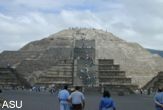Grisly Sacrifices Found in Pyramid of the Moon

New discoveries at an ancient burial site near Mexico City suggest grisly sacrifices and a materialistic society, scientists said Thursday.
Teotihuacan's Pyramid of the Moon was built by an unknown group of people about 2,000 years ago. The surrounding ruins, a master-planned metropolis sprawling over 8 square miles, is thought to have been the first great city of the Western Hemisphere.
A newfound burial vault contains the remains of 12 people, all apparently sacrificed. Ten of them were decapitated. The vault also contained a large variety of offerings and the remains of various animals of clearly symbolic importance, scientists said.
"What we have found in this excavation suggests that a certain kind of mortuary ritual took place inside the tomb before it was filled in," said Saburo Sugiyama, a professor at Aichi Prefectural University in Japan and at Arizona State University. "It is hard to believe that the ritual consisted of clean symbolic performances -- it is most likely that the ceremony created a horrible scene of bloodshed with sacrificed people and animals."
The victims had had their hands bound behind their backs. The decapitated bodies appear to have been tossed, rather than arranged, on one side of the burial. The other two bodies were "richly ornamented" with jewelry indicating high rank.
"Whether the victims and animals were killed at the site or a nearby place, this foundation ritual must have been one of the most terrifying acts recorded archaeologically in Mesoamerica," Sugiyama said.
Teotihuacan reached its height around the same time as the early stages of the Mayan cities farther south, but the cultures were different and appeared to interact little.
Get the world’s most fascinating discoveries delivered straight to your inbox.
Among the new findings was a mosaic human figure, a small figurine that intrigued the researchers.
"The mosaic figure was found on top of 18 large obsidian knives, carefully set in a radial pattern. Nine of these had a curving form, while the nine others had the form of the feathered serpent, a symbol of maximum political authority," Sugiyama said. "Evidently this offering in some way formed the central symbolic meaning of the grave complex."
 Live Science Plus
Live Science Plus






